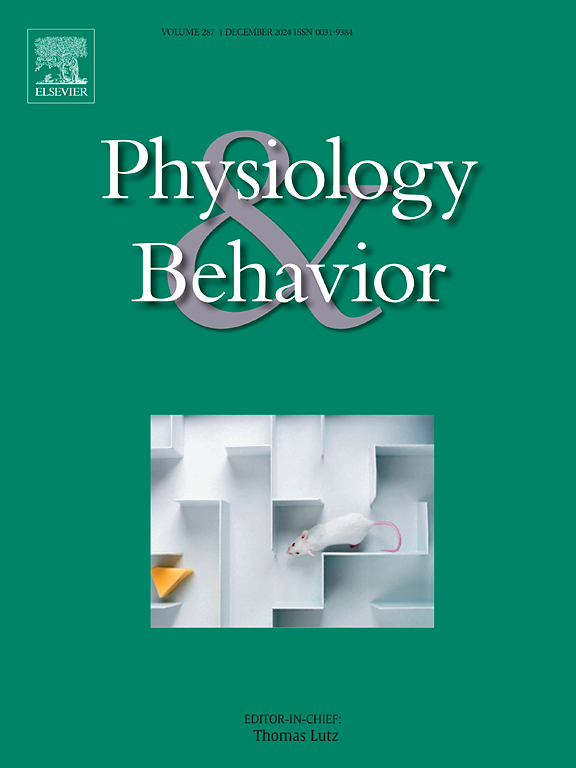Glial fibrillary acidic protein vs. S100B to identify astrocytes impacted by sex and high fat diet
IF 2.5
3区 医学
Q2 BEHAVIORAL SCIENCES
引用次数: 0
Abstract
The brain modulates energy balance by coordinating energy intake and energy expenditure to prevent metabolic diseases. Most research has focused on the role of neurons in this process, but recent work also implicates roles for astrocytes in energy balance. For example, astrocytes in the arcuate nucleus of the hypothalamus become reactive after mice are fed high fat diet (HFD) and their altered function is thought to contribute to obesity. However, limitations in labeling astrocytes in other brain areas has hindered determination of their roles in normal and altered energy balance. Reactive astrocytes increase expression of glial fibrillary acidic protein (GFAP), hence, GFAP has been commonly used as an astrocyte marker. Yet, there is scant immunolabeling of GFAP in brains of chow-fed mice, despite the presence of abundant astrocytes. These findings underscore the need for a marker to visualize astrocytes throughout the brain during normal physiology and exposure to diet-induced obesity, to permit study of how and where they contribute to energy balance. Here we compared immunofluorescence labeling of GFAP and another protein expressed in astrocytes, the S100 calcium binding protein beta (S100B), in brain sections from chow- and HFD-fed female and male mice. We compared the number of labeled cells in areas pertinent to control of ingestive behavior including the arcuate nucleus, lateral hypothalamic area, paraventricular nucleus, lateral preoptic area, and the periaqueductal gray. There was low GFAP expression throughout these brain regions that increased in some brain areas from HFD-fed mice, but intriguingly this only occurred in males. In contrast, S100B labeled more cells than GFAP in each of these areas but its expression was not altered by HFD or sex in most cases. Overall, these data suggest that S100B is superior to GFAP for visualizing astrocytes throughout the brain in both sexes regardless of diet exposure. This study will be a useful resource for researchers who want to identify and study astrocytes in response to diet and in other physiological contexts.
胶质原纤维酸性蛋白与S100B鉴别受性别和高脂肪饮食影响的星形胶质细胞
大脑通过协调能量摄入和能量消耗来调节能量平衡,以预防代谢性疾病。大多数研究都集中在神经元在这一过程中的作用,但最近的工作也暗示星形胶质细胞在能量平衡中的作用。例如,小鼠在喂食高脂肪食物(HFD)后,下丘脑弓状核中的星形胶质细胞变得活跃,它们功能的改变被认为是导致肥胖的原因。然而,标记其他脑区星形胶质细胞的局限性阻碍了确定它们在正常和改变的能量平衡中的作用。反应性星形胶质细胞增加胶质原纤维酸性蛋白(GFAP)的表达,因此GFAP已被广泛用作星形胶质细胞的标志物。然而,尽管存在丰富的星形胶质细胞,但在小鼠的大脑中缺乏GFAP的免疫标记。这些发现强调了在正常生理和暴露于饮食引起的肥胖期间,需要一种标记物来可视化整个大脑的星形胶质细胞,以便研究它们如何以及在何处促进能量平衡。在这里,我们比较了GFAP和另一种在星形胶质细胞中表达的蛋白,S100钙结合蛋白β (S100B)的免疫荧光标记,这些蛋白来自于喂食了松狮饲料和hfd的雌性和雄性小鼠的脑组织。我们比较了与摄食行为控制相关区域的标记细胞数量,包括弓状核、外侧下丘脑区、室旁核、外侧视前区和导水管周围灰质。在喂食hfd的小鼠中,GFAP在这些脑区表达较低,在某些脑区表达增加,但有趣的是,这种情况只发生在雄性小鼠中。相比之下,S100B在这些区域比GFAP标记更多的细胞,但在大多数情况下,它的表达不受HFD或性别的影响。总的来说,这些数据表明S100B在观察整个大脑的星形胶质细胞方面优于GFAP,而与饮食暴露无关。这项研究将为那些想要识别和研究星形胶质细胞对饮食和其他生理环境的反应的研究人员提供有用的资源。
本文章由计算机程序翻译,如有差异,请以英文原文为准。
求助全文
约1分钟内获得全文
求助全文
来源期刊

Physiology & Behavior
医学-行为科学
CiteScore
5.70
自引率
3.40%
发文量
274
审稿时长
47 days
期刊介绍:
Physiology & Behavior is aimed at the causal physiological mechanisms of behavior and its modulation by environmental factors. The journal invites original reports in the broad area of behavioral and cognitive neuroscience, in which at least one variable is physiological and the primary emphasis and theoretical context are behavioral. The range of subjects includes behavioral neuroendocrinology, psychoneuroimmunology, learning and memory, ingestion, social behavior, and studies related to the mechanisms of psychopathology. Contemporary reviews and theoretical articles are welcomed and the Editors invite such proposals from interested authors.
 求助内容:
求助内容: 应助结果提醒方式:
应助结果提醒方式:


